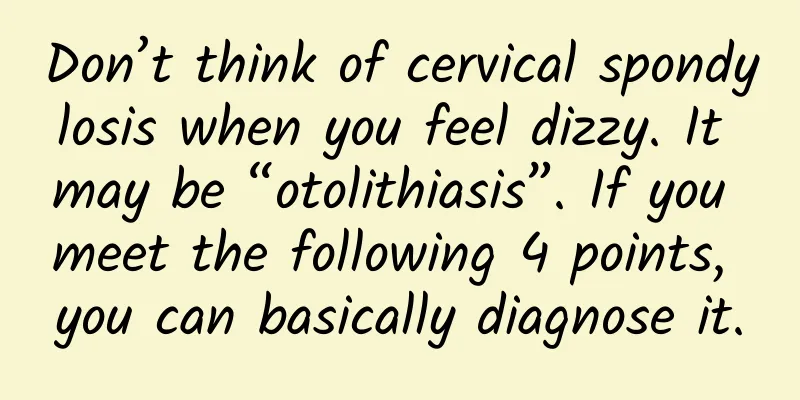Don’t think of cervical spondylosis when you feel dizzy. It may be “otolithiasis”. If you meet the following 4 points, you can basically diagnose it.

|
Have you ever experienced this: waking up in the morning and suddenly feeling dizzy and even unsteady? This vertigo may not be as simple as cervical spondylosis or insufficient blood supply to the brain as you imagine. In fact, according to clinical experience, this sudden, position-related vertigo is mostly caused by a disease called " otolithiasis ". What is otolithiasis? Otolithiasis sounds like it has something to do with earwax, but it is not. It is also called " benign paroxysmal positional vertigo ", which refers to a disease in which otoliths (calcium carbonate crystals) in the inner ear fall off and enter the semicircular canals in the ear, moving with changes in the position of the head, causing vertigo. Zeqiao original copyright contact Normally, otoliths are located on the utricle and saccule of the inner ear, helping us sense changes in center of gravity and speed and maintaining body balance . But when they are out of place, problems arise. Dizziness when the head moves is a typical symptom Symptoms of otolithiasis can be identified by the following characteristics: 1. Benign: Otolithiasis is a self-limiting disease that usually resolves on its own in about a week. However, during this time, patients may experience severe dizziness and nausea. 2. Paroxysmal: Each attack is very short, ranging from a few seconds to tens of seconds, and rarely exceeds one minute. 3. Positional: Symptoms usually occur when the position of the head changes, such as dizziness when getting up in the morning, turning over at night, lying down, looking up or lowering the head. When the head is still, the dizziness disappears. 4. Dizziness: Patients often feel as if the surrounding environment is spinning, accompanied by symptoms such as nausea, vomiting, and difficulty walking. For otolithiasis, doctors usually use manual repositioning to treat it. Through professional manual manipulation, the otoliths are returned to their original position. Most people will experience significant improvement in their vertigo symptoms after receiving repositioning treatment. However, it should be noted that reduction treatment must be performed by a professional doctor, especially for patients who also suffer from cervical spondylosis. Improper operation may cause cervical spine injury. How to prevent relapse? Although otolithiasis is benign, there is still a chance of recurrence after the otoliths return to their original positions. Here are some tips to prevent recurrence: • On the day of resetting : Sit quietly for half an hour to help the otoliths stabilize. • Within 3 days : Try to raise the head of the bed 45 degrees. You can use a quilt to create a slope. Avoid simply raising the pillow to avoid affecting the cervical spine. • For one week : Avoid activities such as dental checkups, which may put your head in a special position and increase the risk of the otoliths being dislodged again. • Within half a month : avoid strenuous exercise, such as mountain climbing, swimming, etc., ensure adequate sleep and a good mood to reduce the chance of recurrence of otolithiasis. Zeqiao original copyright contact Who is more likely to suffer from otolithiasis? The occurrence of otolithiasis is related to many factors, including but not limited to: • Older people , especially those between 40 and 60 years of age, because this age group may have chronic vestibular ischemia. • Young people who are overworked, stressed, and have poor sleep quality often have a lifestyle that is prone to otolithiasis. • Women , especially those with weaker constitutions, have a higher incidence rate. • For patients with osteoporosis , since otoliths contain calcium carbonate, osteoporosis may cause local structural changes and increase the risk of disease. • Other diseases, such as Meniere's disease, otitis media, etc. may also be the cause of otolithiasis. I hope this article can help you better understand otolithiasis and take appropriate protective measures in your life. If you or your friends have similar symptoms, please remember to seek medical attention in time! |
>>: Don’t ever have this kind of “mindset”!
Recommend
Can you believe it? It was once freezing cold near the equator
Angola, Africa, near the equator, has a tropical ...
Feeding groundhogs has become a trend, but experts warn against it! This cute groundhog is the source of the Black Death
The Ningxia Hui Autonomous Region Health Commissi...
The efficacy and function of Yangti leaf
Sheep's foot leaf can not only supplement the...
The efficacy and function of Salvia miltiorrhiza
Salvia miltiorrhiza is rich in nutritional value ...
What are the effects and functions of Qianghuo?
In our daily life, we often use some Chinese medi...
Can Chinese medicine strengthen the kidneys and improve sexual function?
Using traditional Chinese medicine to strengthen ...
The efficacy and function of winter melon seeds
Winter melon is a vegetable that many people are ...
Bundling wind, solar and thermal power for external transmission? The transformation from transmitting "coal-fired power" to transmitting "green power"
Editor’s Note: Millions of IPs create science pop...
Microphone in the universe: Why do scientists want to listen to the sounds of alien worlds?
NASA's Perseverance rover, currently working ...
Do you recommend that you sleep less? Do you recommend that you don't sleep less?
Yesterday, Zhang Chaoyang's suggestion that e...
The efficacy and function of Chinese Saijue bed
Chinese Saijue Chuang is a kind of traditional Ch...
Mysterious "skull" pattern appears on preserved eggs? How did the strange "pine flower" pattern form?
There is a long-standing rumor that a peasant wom...
Sunbathing my back for 10 days made me lose 4 catties. Can sunbathing your back during the dog days really help you lose weight? The truth is →
"Sunbathing your back more during the dog da...









